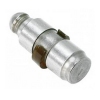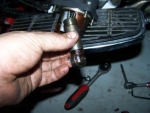Hydraulic Lifter
What is the function of your hydraulic lifter ?
The hydraulic lifter in a car's engine uses oil pressure to adjust a plunger and take up all the clearance in the valve train. This helps to ensure less engine noise and longer reliability, due to less wear and tear. A faulty hydraulic lifter will usually result in the rocker arm, valve tip and push rod also going bad if left unattended.
 Signs of a Faulty Hydraulic Lifter
Signs of a Faulty Hydraulic LifterThe most obvious symptom of a faulty hydraulic lifter is the noise it creates in your car's engine. You can usually distinguish the faulty lifter by the distinct sound. Instead of a knock or ping, a faulty hydraulic lifter will usually make a sound more reminiscent of a tapping sound. The tapping will be quick in rhythm and may occur when the vehicle is cold or hot, depending on what the problem with the hydraulic lifter is. The lifter may be having problems with a sticking check valve, dirt, wear or other problems.
|
If your car has a faulty hydraulic lifter, replace it as soon as possible to avoid further damaging your engine.
In most cases, a faulty hydraulic lifter will simply need to be replaced. You might be able to get away with replacing a single bad hydraulic filter depending on the make and model of your vehicle. However, many mechanics suggest that when replacing one lifter, you should go ahead and replace them all, because it's generally a good indication that others will soon fail.
Depending upon the age of your vehicle, you might consider using refurbished lifters in your vehicle rather than purchasing new ones. Refurbished hydraulic lifters will cost a lot less money and will usually do an adequate job for older used vehicles, which may not have many more years of service left in them.

1. Prepare Top of Engine
2. Remove Valve Covers : The valve covers are removed with the use of the right sized socket. There are several bolts on each of the covers that hold it in place. Once all of the bolts are removed, pry the cover off of the block with a
3. Move Cylinder to Top Center : Once the valve covers have been removed, you will need to bring the number 1 cylinder to the top center position. Move the cylinder and watch to make sure that the valves are closed. Remove the intake manifold bolts and make careful observations of their exact placement to make reassembly easier. Pry the intake and loosen up the manifold.
4. Clean Off Manifold Gaskets : It is important to clean off all of the residue left over from the gaskets on the manifold. Use a gasket scraper, a wire brush, and some solvent in order to clean this left over residue.
5. Remove Hydraulic Lifters : Once the manifold is clean, you can then loosen the bolts for the rocker arm assembly. Move this to the side far enough to be able to access the push rods. Check each rod for any damage. With the use of a strong magnet you can then lift out the hydraulic lifters.
6. Replace Hydraulic Lifters : Place the new hydraulic lifters into the passages and make sure that they can rotate a complete 360 degrees. Place the push rods back into position and tighten the rocker arm assembly. Tighten the rocker arm until there is a 0.10 inch gap between the arm and the valve stem. Repeat this same measurement for each cylinder in the firing order.
7. Apply New Gaskets : Apply the new gasket onto the intake manifold and tighten it into position. Remove the old valve cover gasket with the scraper and solvent. Once the valve covers are clean, apply the new gasket and seal them with gasket sealer.
8. Tighten Bolts : Use a torque wrench and tighten the valve cover bolts to manufacturer specifications. Replace the electrical wiring, and other components, and run the engine to make sure the lifters are working properly.


